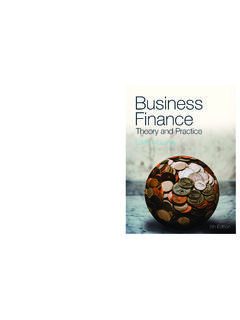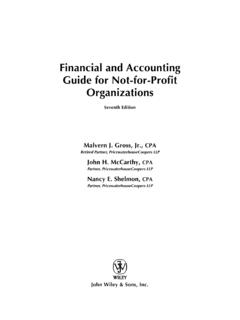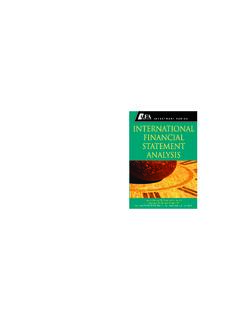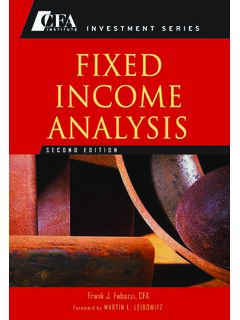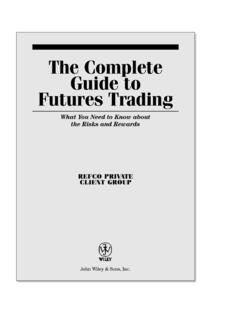Transcription of Finance - MEC
1 FinanceMcGraw Hill PrimisISBN: 0 390 32002 1 Text: Investments, Fifth EditionBodie Kane MarcusCourse:InvestmentsInstructor:David WhitehurstUMISTV olume 1 McGraw-Hill/ 2003 by The McGraw Hill Companies, Inc. All rights reserved. Printed in the United States of America. Except as permitted under the United States Copyright Act of 1976, no part of this publication may be reproduced or distributed in any form or by any means, or stored in a database or retrieval system, without prior written permission of the publisher. This McGraw Hill Primis text may include materials submitted to McGraw Hill for publication by the instructor of this course. The instructor is solely responsible for the editorial content of such : 0 390 32002 1 This book was printed on recycled 1 Bodie Kane Marcus Investments, Fifth Edition Front Matter 1 Preface 1 Walk Through 9I.
2 Introduction 131. The Investment Environment 132. Markets and Instruments 383. How Securities Are Traded 754. Mutual Funds and Other Investment Companies 1145. History of Interest Rates and Risk Premiums 142II. Portfolio Theory 1636. Risk and Risk Aversion 1637. Capital Allocation between the Risky Asset and the Risk Free Asset 1928. Optimal Risky Portfolio 216 III. Equilibrium In Capital Markets 2669. The Capital Asset Pricing Model 26610. Single Index and Multifactor Models 30011. Arbitrage Pricing Theory 32812. Market Efficiency 34813. Empirical Evidence on Security Returns 390IV. Fixed Income Securities 42114. Bond Prices and Yields 42115. The Term Structure of Interest Rates 45916. Managing Bond Portfolios 489V. Security Analysis 53717. Macroeconomics and Industry Analysis 53718.
3 Equity and valuation Models 56719. Financial Statement Analysis 611VI. Options, Futures, and Other Derivatives 65220. Options Markets: Introduction 65221. Option valuation 70022. Futures Markets 74323. Futures and Swaps: A Closer Look 770iiiVII. Active Portfolio Management 80824. Portfolio Performance Evaluation 80825. International Diversification 85026. The Process of Portfolio Management 875ivBodie Kane Marcus: Investments, Fifth EditionFront MatterPreface1 The McGraw Hill Companies, 2001P R E F A C EWe wrote the first edition of this textbook more than ten years ago. The intervening yearshave been a period of rapid and profound change in the investments industry. This is due inpart to an abundance of newly designed securities, in part to the creation of new tradingstrategies that would have been impossible without concurrent advances in computer tech-nology, and in part to rapid advances in the theory of investments that have come out of theacademic community.
4 In no other field, perhaps, is the transmission of theory to real-worldpractice as rapid as is now commonplace in the financial industry. These developmentsplace new burdens on practitioners and teachers of investments far beyond what was re-quired only a short while , Fifth Edition, is intended primarily as a textbook for courses in investmentanalysis. Our guiding principle has been to present the material in a framework that is or-ganized by a central core of consistent fundamental principles. We make every attempt tostrip away unnecessary mathematical and technical detail, and we have concentrated onproviding the intuition that may guide students and practitioners as they confront new ideasand challenges in their professional text will introduce you to major issues currently of concern to all investors.
5 It cangive you the skills to conduct a sophisticated assessment of current issues and debates cov-ered by both the popular media as well as more specialized Finance journals. Whether youplan to become an investment professional, or simply a sophisticated individual investor,you will find these skills essential. Our primary goal is to present material of practical value, but all three of us are activeresearchers in the science of financial economics and find virtually all of the material inthis book to be of great intellectual interest. Fortunately, we think, there is no contradictionin the field of investments between the pursuit of truth and the pursuit of money. Quite theopposite. The capital asset pricing model, the arbitrage pricing model, the efficient marketshypothesis, the option-pricing model, and the other centerpieces of modern financialresearch are as much intellectually satisfying subjects of scientific inquiry as they are ofimmense practical importance for the sophisticated our effort to link theory to practice, we also have attempted to make our approachconsistent with that of the Institute of Chartered Financial Analysts (ICFA), a subsidiary ofthe Association of Investment Management and Research (AIMR).
6 In addition to fosteringresearch in Finance , the AIMR and ICFA administer an education and certification programto candidates seeking the title of Chartered Financial Analyst (CFA). The CFA curriculumrepresents the consensus of a committee of distinguished scholars and practitioners re-garding the core of knowledge required by the investment are many features of this text that make it consistent with and relevant to the CFAcurriculum. The end-of-chapter problem sets contain questions from past CFA exams, and,for students who will be taking the exam, Appendix B is a useful tool that lists each CFAquestion in the text and the exam from which it has been taken. Chapter 3 includes excerptsfrom the Code of Ethics and Standards of Professional Conduct of the ICFA. Chapter 26,which discusses investors and the investment process, is modeled after the ICFA the Fifth Edition, we have introduced a systematic collection of Excel spreadsheets thatgive students tools to explore concepts more deeply than was previously possible.
7 TheseviBodie Kane Marcus: Investments, Fifth EditionFront MatterPreface2 The McGraw Hill Companies, 2001 PREFACE viispreadsheets are available through the World Wide Web, and provide a taste of the sophisti-cated analytic tools available to professional investors. UNDERLYING PHILOSOPHYOf necessity, our text has evolved along with the financial markets. In the Fifth Edition, weaddress many of the changes in the investment the same time, many basic principlesremain important. We believe that attention tothese few important principles can simplify the study of otherwise difficult material andthat fundamental principles should organize and motivate all study. These principles arecrucial to understanding the securities already traded in financial markets and in under-standing new securities that will be introduced in the future.
8 For this reason, we have madethis book thematic, meaning we never offer rules of thumb without reference to the centraltenets of the modern approach to common theme unifying this book is that security markets are nearly efficient,meaning most securities are usually priced appropriately given their risk and return attri-butes. There are few free lunches found in markets as competitive as the financial simple observation is, nevertheless, remarkably powerful in its implications for thedesign of investment strategies; as a result, our discussions of strategy are always guidedby the implications of the efficient markets hypothesis. While the degree of market effi-ciency is, and always will be, a matter of debate, we hope our discussions throughout thebook convey a good dose of healthy criticism concerning much conventional ThemesInvestments is organized around several important themes:1.
9 The central theme is the near-informational-efficiency of well-developed securitymarkets, such as those in the United States, and the general awareness thatcompetitive markets do not offer free lunches to second theme is the risk return trade-off. This too is a no-free-lunch notion,holding that in competitive security markets, higher expected returns come only ata price: the need to bear greater investment risk. However, this notion leavesseveral questions unanswered. How should one measure the risk of an asset? Whatshould be the quantitative trade-off between risk (properly measured) and expectedreturn? The approach we present to these issues is known as modern portfoliotheory, which is another organizing principle of this book. Modern portfolio theoryfocuses on the techniques and implications of efficient diversification, and wedevote considerable attention to the effect of diversification on portfolio risk aswell as the implications of efficient diversification for the proper measurement ofrisk and the risk return This text places greater emphasis on asset allocation than most of its prefer this emphasis for two important reasons.
10 First, it corresponds to theprocedure that most individuals actually follow. Typically, you start with all of yourmoney in a bank account, only then considering how much to invest in somethingriskier that might offer a higher expected return. The logical step at this point is toconsider other risky asset classes, such as stock, bonds, or real estate. This is anasset allocation decision. Second, in most cases, the asset allocation choice is farmore important in determining overall investment performance than is the set ofBodie Kane Marcus: Investments, Fifth EditionFront MatterPreface3 The McGraw Hill Companies, 2001security selection decisions. Asset allocation is the primary determinant of the risk-return profile of the investment portfolio, and so it deserves primary attention in astudy of investment This text offers a much broader and deeper treatment of futures, options, and otherderivative security markets than most investments texts.

